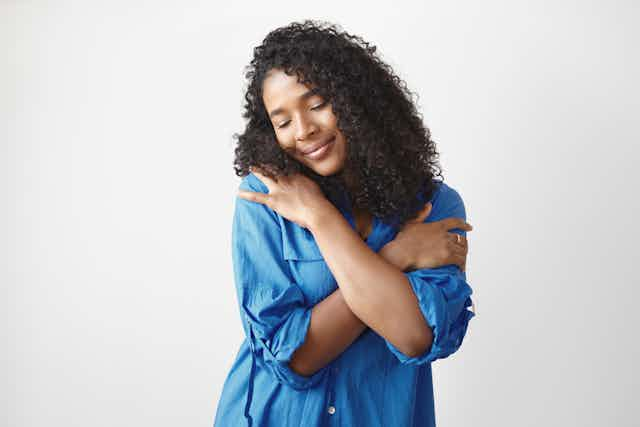These days it’s hard to miss the body positivity movement. But love and respect for the body isn’t new and wasn’t invented by the west. Indeed, global research I’ve collaborated on has found that body appreciation is understood and experienced the same way all over the world – even if we did find large differences in levels of body appreciation between different countries.
But first, it’s important to understand what body image and body appreciation mean in psychology.
Body image is the “inside view” that you have of yourself. Historically, body image research was focused on negative aspects, such as appearance anxiety or clinical conditions including body dysmorphic disorder. Over the past two decades, however, the study of positive body image has gained momentum.
There are different forms of positive body image, but perhaps the most important and most widely studied is body appreciation.
People who have high body appreciation are more likely to appreciate the unique characteristics of, and be attentive to the needs of, their bodies. These people also tend to reject narrow appearance ideals as the only form of human beauty.
Body positivity is a movement that promotes positive views of all bodies, whereas body appreciation is an inner relationship to your own body.
Body appreciation in diverse populations
Body appreciation is usually measured by researchers using the Body Appreciation Scale-2 (BAS-2), which includes statements such as “I respect my body” and “I feel love for my body”. An important question for scientists is whether the BAS-2 measures body appreciation in the same way for different groups of people.
To answer this question, my colleagues and I in the Body Image in Nature Survey – a consortium of 253 international scientists – asked participants from 65 countries speaking 40 different languages to complete the BAS-2. In one of the largest studies ever conducted on body image, we found that the BAS-2 was understood in the same way across all communities.
Other studies have found that the BAS-2 is understood in much the same way across sexual orientations and gender identities. This means that body appreciation can be considered a good example of a positive phenomenon, much like feelings of happiness and life satisfaction.
It also means scientists can compare levels of body appreciation across diverse communities. In our cross-national study, we found large differences in body appreciation across countries – with Malta, Taiwan and Bangladesh having the highest overall scores, and Australia, India and the UK having the lowest. One possibility, supported by our findings, is that greater cultural distance from westernised contexts allows people to disentangle their self-worth from their physical appearance.

Other work has shown that men tend to have higher body appreciation than women, and that body appreciation increases with age. It may be that men and older people tend to experience less pressure to attain prescriptive appearance ideals.
When does it start?
Experiences of body appreciation often develop early in life. For example, interviews with Swedish adolescents who were satisfied with their appearance found that they accepted their physical imperfections. These adolescents seemed to appreciate what the body is able to do, rather than what it looks like.
Social contexts in which people can feel acceptance and belonging – such as supportive friends and encouraging romantic partners – are crucial for the early development of body appreciation.
In these and other interviews, participants typically say that excelling in physical or other activities, such as singing or exploring one’s sexuality, helped them develop feelings of agency and body appreciation.
Why is body appreciation important?
There are many reasons why developing body appreciation is beneficial. For example, greater body appreciation is reliably associated with heathier eating styles. It also reduces the likelihood of experiencing symptoms of eating disorders, including binge eating and restrictive eating.
Body appreciation is also associated with more positive mental health. A 2022 review of 240 papers found that higher levels of body appreciation were associated with greater self-compassion and life satisfaction, as well as fewer symptoms of anxiety and depression.
Greater body appreciation is also associated with healthier lifestyle choices. Another 2022 review of nine studies with mostly western participants found that body appreciation was associated with less health-compromising behaviour, including risky sexual activity and alcohol abuse.
Other research has found that greater body appreciation provides a strong foundation for developing more liberal, sex-positive attitudes, as well as more positive sexual experiences including sexual satisfaction. Additionally, greater body appreciation is associated with more positive attitudes toward breastfeeding and stronger motivation to engage in physical activity.
Promoting body appreciation
What all of these studies suggest is that greater body appreciation can provide a strong platform for all manner of positive behaviour and attitudes. When people appreciate their bodies, they are more likely to be attentive to their bodily needs and feel more connected to their bodies. This, in turn, motivates a desire to maintain good mental and physical health.
For children and adolescents, yoga and physical activity are beneficial, and there are also picture books that can help children understand what body appreciation looks and feels like.
For adults, many embodying activities – things that promote a sense of inhabiting our bodies – can promote body appreciation. Examples include dance and other forms of physical activity, life drawing, and even just going for a walk in nature.

